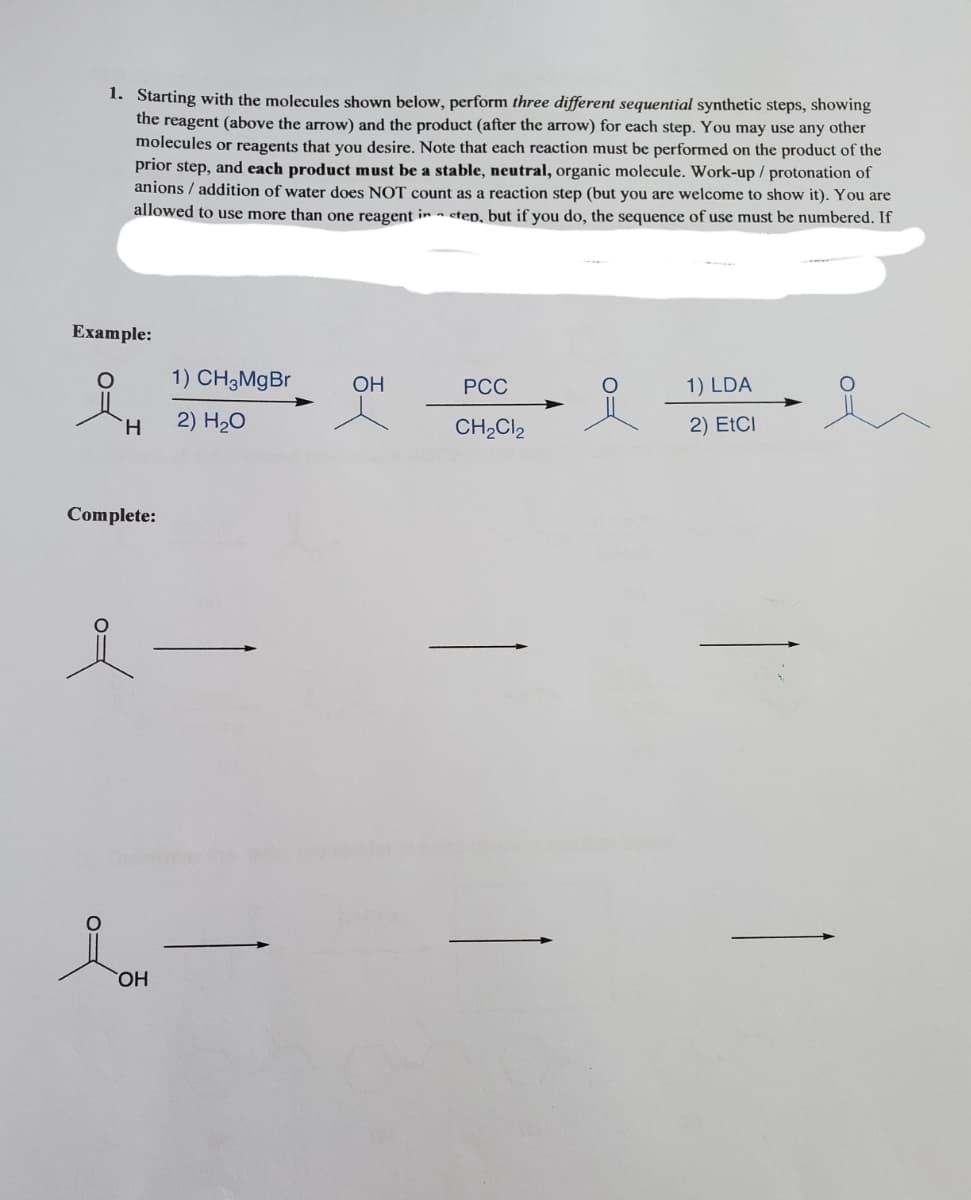1. Starting with the molecules shown below, perform three different sequential synthetic steps, showing the reagent (above the arrow) and the product (after the arrow) for each step. You may use any other molecules or reagents that you desire. Note that each reaction must be performed on the product of the prior step, and each product must be a stable, neutral, organic molecule. Work-up/ protonation of anions / addition of water does NOT count as a reaction step (but you are welcome to show it). You are allowed to use more than one reagent in etep, but if you do, the sequence of use must be numbered. If Example: 1) CH3MgBr OH РСС 1) LDA H. 2) H20 CH2CI2 2) ELCI Complete: HO,
1. Starting with the molecules shown below, perform three different sequential synthetic steps, showing the reagent (above the arrow) and the product (after the arrow) for each step. You may use any other molecules or reagents that you desire. Note that each reaction must be performed on the product of the prior step, and each product must be a stable, neutral, organic molecule. Work-up/ protonation of anions / addition of water does NOT count as a reaction step (but you are welcome to show it). You are allowed to use more than one reagent in etep, but if you do, the sequence of use must be numbered. If Example: 1) CH3MgBr OH РСС 1) LDA H. 2) H20 CH2CI2 2) ELCI Complete: HO,
Organic Chemistry: A Guided Inquiry
2nd Edition
ISBN:9780618974122
Author:Andrei Straumanis
Publisher:Andrei Straumanis
Chapter16: Synthesis Workshop 1
Section: Chapter Questions
Problem 25E
Related questions
Question

Transcribed Image Text:1. Starting with the molecules shown below, perform three different sequential synthetic steps, showing
the reagent (above the arrow) and the product (after the arrow) for each step. You may use any other
molecules or reagents that you desire. Note that each reaction must be performed on the product of the
prior step, and each product must be a stable, neutral, organic molecule. Work-up / protonation of
anions / addition of water does NOT count as a reaction step (but you are welcome to show it). You are
allowed to use more than one reagent in step, but if you do, the sequence of use must be numbered. If
Example:
1) CH3MgBr
OH
РСС
1) LDA
H.
2) H20
CH2CI2
2) EtCI
Complete:
HO
Expert Solution
This question has been solved!
Explore an expertly crafted, step-by-step solution for a thorough understanding of key concepts.
This is a popular solution!
Trending now
This is a popular solution!
Step by step
Solved in 2 steps with 2 images

Knowledge Booster
Learn more about
Need a deep-dive on the concept behind this application? Look no further. Learn more about this topic, chemistry and related others by exploring similar questions and additional content below.Recommended textbooks for you

Organic Chemistry: A Guided Inquiry
Chemistry
ISBN:
9780618974122
Author:
Andrei Straumanis
Publisher:
Cengage Learning

Organic Chemistry: A Guided Inquiry
Chemistry
ISBN:
9780618974122
Author:
Andrei Straumanis
Publisher:
Cengage Learning